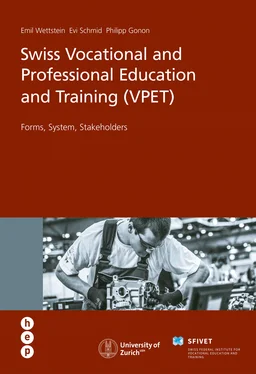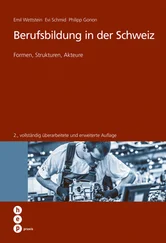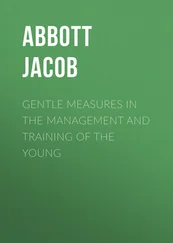Combined school/work-based VET (“company-based VET”) is predominant in VET: only around 10 per cent of learners obtain their Federal VET Diploma or their Federal VET Certificate in a school-based VET programme, in German-speaking Switzerland, this figure is much lower while in French-speaking Switzerland, it is considerably higher. Nevertheless, the range of programmes is very wide: in 2010, a total of 225 providers were recorded (Wettstein & Amos, 2010, p. 41 et seqq.). Binding lists exist for the providers for which the cantons receive federal funding.[2]
School-based VET programmes are repeatedly a topic of educational policy debates. The training costs the public sector many times more than the combined school/work-based equivalent. Their orientation towards the labour market is questioned, and the influence of companies is less than with combined school/work-based VET programmes. Unlike other European countries (cf. loc. cit, pp. 20–25), in Switzerland they are complementary and therefore subsidiary and should continue not being in competition with company-based VET. They can (or could) bridge gaps in the market, in particular:
•as an opportunity for young people who cannot find a position in host companies,
•to even out economic fluctuations,
•for branches of industry without sufficient VET,
•to open up new areas of the world of work for VPET,
•to launch new lines of business in a region,
•to maintain traditional professions and technologies,
•to enable upper-secondary school graduates to complete traineeships,
•as opportunities for young people who want to continue to attend a school and not primarily to prepare for academic studies but rather to prepare for gainful employment.
Commercial schools
For commercial training, back in the 19th century an alternative to apprenticeships was already developed: commercial schools (Handelsschulen) (cf. Wettstein, 1987, p. 38).
The commercial schools, today called Handelsmittelschulen (HMS), are vocational upper-secondary schools, often also called Wirtschaftsmittelschulen. Previously, they generally prepared young people for a commercial school diploma, since the beginning of training in 2010 or 2011 – depending on the canton – the graduates have obtained a Federal VET Diploma (EFZ) and usually pass the Federal Vocational Baccalaureate Examination like learners in corresponding combined school/work-based VET programmes.
VET programmes without a Federal Vocational Baccalaureate Examination take three years at commercial schools; if preparation for the Federal Vocational Baccalaureate Examination is included, the programmes last three or four years.
For work-based training there are two educational models available (Federal Office for Professional Education and Technology; OPET, 2009):
Model i : in the “integrated model”, the practical parts and traineeships in companies are continually integrated in the school programme. Work-based training, in addition to a short traineeship of four weeks, comprises at least 1,220 lessons covering “problem-oriented teaching” (problemorientierter Unterricht, POU) in languages and other specialist areas as well as “integrated practical parts” (integrierte Praxisteile, IPT), for example in the form of junior companies (Juniorfirmen) (OPET, 2009).
Model 3+1 : the second model is characterised by a long traineeship of at least twelve months towards the end of the programme. The other elements of work-based training are continually integrated in school lessons. At least 880 lessons must be earmarked for this in the syllabus. This model is possible only if the Federal VET Diploma with Federal Vocational Baccalaureate is targeted.
In 2016, there were 75 commercial schools in Switzerland, most of them located in the French-speaking part of the country (SERI, 2016g). In 2015, a total of 2,385 students obtained the qualification of a Federal VET Diploma in Commerce, Extended Basic Training (Kaufmann/Kauffrau mit E-Profil) at a school compared to 9,336 in a combined school/work-based VET programme.
Information technology schools (IT schools)
Information technology schools (Informatikmittelschulen, IMS) are commercial schools which prepare students for the qualification procedure to become an IT technician in conjunction with a commercial Federal Vocational Baccalaureate (cf. the portrait of Claudia Juon, p. 36). The IT schools were established at the end of the 1990s when more training places for IT technicians were badly needed. In 2016, there were IT schools in Aarau, Baden, Basel, Berne, Frauenfeld, Winterthur and Zurich, which took in an annual total of around 200 learners, corresponding to approximately 10 per cent of the learners in this occupational field, another school is in preparation in Lucerne.
They follow the model 3+1, which is common for many school-based VET programmes, in particular for the commercial schools: a three-year school-based programme is followed by a one-year training programme in a firm.
Alongside the commercial schools and the IT schools, the trade schools (full-time vocational schools including work-based training and classroom instruction) are the most common form of school-based VET programmes (in some cases also called “school-supported programmes” (schulgestützte Ausbildungen)). They are described in Chapter 1.5 (cf. p. 38). Special needs and social education establishments also offer school-based VET programmes. The training of artists (music, dance) is also mostly school-based, and finally there are specialist classes for training graphic designers.
Not all programmes between the two large blocks upper-secondary level baccalaureate school and VET are to be counted among school-based VET programmes, in particular not the specialised schools (Fachmittelschulen).
The specialised schools are sometimes combined with school-supported VET programmes, however: the Fach- und Mittelschulzentrum (Professional and Upper-Secondary School Centre) in Lucerne, in addition to the specialised school, also comprises the commercial school (Wirtschaftsmittelschule, HMS), health care school (Gesundheitsmittelschule) which leads to the vocational qualification Health Care Assistant, Federal VET Diploma (Fachmann/Fachfrau Gesundheit EFZ), and a specialist class in graphic art. The specialised schools in Delémont and Canobbio also lead to the vocational qualification Health Care Assistant, Federal VET Diploma.
Increasingly, there are combined programmes where the first part of a VET programme is at school and the second part is in the form of company-based VET. Examples are programmes by cooperative training associations, company-based VET programmes with traineeship entry years and also some full-time VET schools and programmes in social education establishments.
Such combinations of school-based VET programmes and combined school/work-based VET programmes could potentially open up further areas of the world of work for VPET, for example by implementing forms of alternance where training blocks at a company and at school alternate (cf. Gindroz, 2004).
PORTRAIT OF CLAUDIA JUON

Claudia Juon, 19,
is attending Frauenfeld Information Technology School and is currently working as a trainee at Bühler AG
clear
When school means practical experience
Getting the commercial Federal Vocational Baccalaureate and the Federal VET Diploma, but twelve weeks of holidays a year – that sounds like education paradise. Claudia Juon is one of the people who lives there.
Читать дальше













